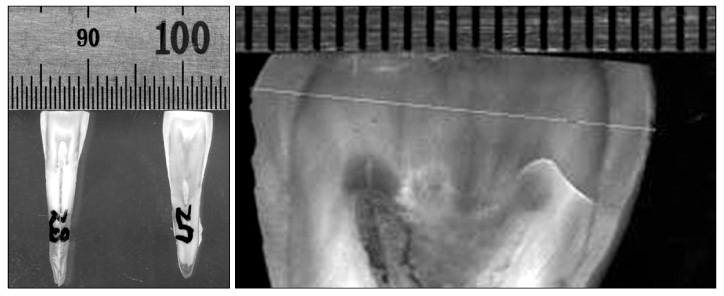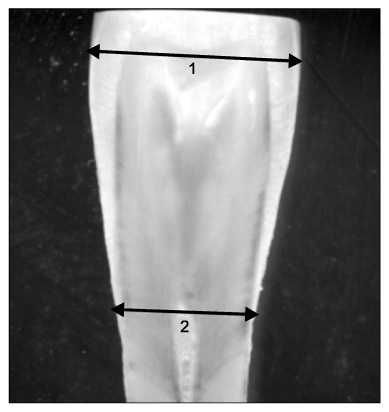Korean J Orthod.
2011 Jun;41(3):184-190. 10.4041/kjod.2011.41.3.184.
Relationship between mesiodistal width and enamel thickness in mandibular incisors
- Affiliations
-
- 1Department of Orthodontics, School of Dentistry, Chosun University, Korea. shlim@chosun.ac.kr
- KMID: 1975430
- DOI: http://doi.org/10.4041/kjod.2011.41.3.184
Abstract
OBJECTIVE
The purpose of this study was to investigate the relationship between the enamel thickness of proximal surfaces and the morphologic features of mandibular incisors.
METHODS
Mesiodistal/faciolingual (MD/FL) index, MD width, and height of contour width/cervical width ratio were measured in 40 incisors extracted from Koreans. For determining the height of contour width/cervical width ratio, the cervical width was measured as the distance between proximal cementoenamel junctions. Then, the labial surface was ground to the height of the contour level to measure enamel thickness. Pearson correlation analysis was used to investigate the correlation between enamel thickness and morphologic features.
RESULTS
Enamel thickness was 0.75 +/- 0.07 mm per side, and MD width was 5.56 +/- 0.40 mm. Enamel thickness and MD width were significantly correlated. However, a significant relationship was not observed between enamel thickness and MD/FL index or the height of contour width/cervical width ratio.
CONCLUSIONS
The results suggest that enamel thickness is affected only by MD width. Therefore, if the MD width is the same for mandibular incisors with a large MD/FL index or triangular shape and mandibular incisors with normal shape, then the limit of enamel reduction for reproximation will be the same.
MeSH Terms
Figure
Reference
-
1. Peck H, Peck S. An index for assessing tooth shape deviations as applied to the mandibular incisors. Am J Orthod. 1972. 61:384–401.
Article2. Peck H, Peck S. Cook JT, editor. Reproximation (enamel stripping) as an essential orthodontic treatment ingredient. Transactions of the Third International Orthodontic Congress held in London, 13-18 August 1973. 1975. 13-18 August 1973; London: Crosby Lockwood Staples;513–523.3. Joseph VP, Rossouw PE, Basson NJ. Orthodontic microabrasive reproximation. Am J Orthod Dentofacial Orthop. 1992. 102:351–359.
Article4. Danesh G, Hellak A, Lippold C, Ziebura T, Schafer E. Enamel surfaces following interproximal reduction with different methods. Angle Orthod. 2007. 77:1004–1010.
Article5. Arman A, Cehreli SB, Ozel E, Arhun N, Cetinşahin A, Soyman M. Qualitative and quantitative evaluation of enamel after various stripping methods. Am J Orthod Dentofacial Orthop. 2006. 130:131.e7–131.e14.
Article6. Zachrisson BU, Nyøygaard L, Mobarak K. Dental health assessed more than 10 years after interproximal enamel reduction of mandibular anterior teeth. Am J Orthod Dentofacial Orthop. 2007. 131:162–169.
Article7. Fillion D. Vor- und Nachteile der approximalen Schmelzreduktion. Inf Orthod Kieferorthop. 1995. 27:64–90.8. Sheridan JJ. Air-rotor stripping. J Clin Orthod. 1985. 19:43–59.9. Boese LR. Fiberotomy and reproximation without lower retention, nine years in retrospect: part I. Angle Orthod. 1980. 50:88–97.10. Houston WJ. The analysis of errors in orthodontic measurements. Am J Orthod. 1983. 83:382–390.
Article11. Baik BJ, Park JY, Kim JG, Lee DC. A study on the size of the permanent teeth. J Korean Acad Pediatr Dent. 2003. 30:502–509.12. Lee SJ, Moon SC, Kim TW, Nahm DS, Chang YI. Tooth size and arch parameters of normal occlusion in a large Korean sample. Korean J Orthod. 2004. 34:473–480.13. Rudolph DJ, Dominguez PD, Ahn K, Thinh T. The use of tooth thickness in predicting intermaxillary tooth-size discrepancies. Angle Orthod. 1998. 68:133–138.14. Sturdevant CM, Roberson TM, Heymann HO, Sturdevant JR. The art and science of operative dentistry. 1995. 3rd ed. St. Louis: Mosby;306–309.15. Sheridan JJ. Air-rotor stripping manual. 2005. Metairie: Raintree Essix;37.16. Hall NE, Lindauer SJ, Tüfekçi E, Shroff B. Predictors of variation in mandibular incisor enamel thickness. J Am Dent Assoc. 2007. 138:809–815.
Article17. Rhee SH, Nahm DS. Triangular-shaped incisor crowns and crowding. Am J Orthod Dentofacial Orthop. 2000. 118:624–628.
Article18. Uysal T, Sari Z. Intermaxillary tooth size discrepancy and mesiodistal crown dimensions for a Turkish population. Am J Orthod Dentofacial Orthop. 2005. 128:226–230.
Article19. Kim KN, Yoon YJ, Kim KW. A study on the enamel surface texture and caries susceptibility in interdentally stripped teeth. Korean J Orthod. 2001. 31:567–578.20. Jarjoura K, Gagnon G, Nieberg L. Caries risk after interproximal enamel reduction. Am J Orthod Dentofacial Orthop. 2006. 130:26–30.
Article
- Full Text Links
- Actions
-
Cited
- CITED
-
- Close
- Share
- Similar articles
-
- A study on the prediction percentile tabulation of the size of the unerupted permanent canines and premolars in Korean population
- Prediction of the sum of mesiodistal widths of the unerupted permanent canines and premolars
- A study on estimating tooth size with regression constants
- A study of dental crowding and its relationship to mandibular incisor shape by model analysis in adolescents
- The effect of mesiodistal crown widths of anterior teeth on incisor relationship



